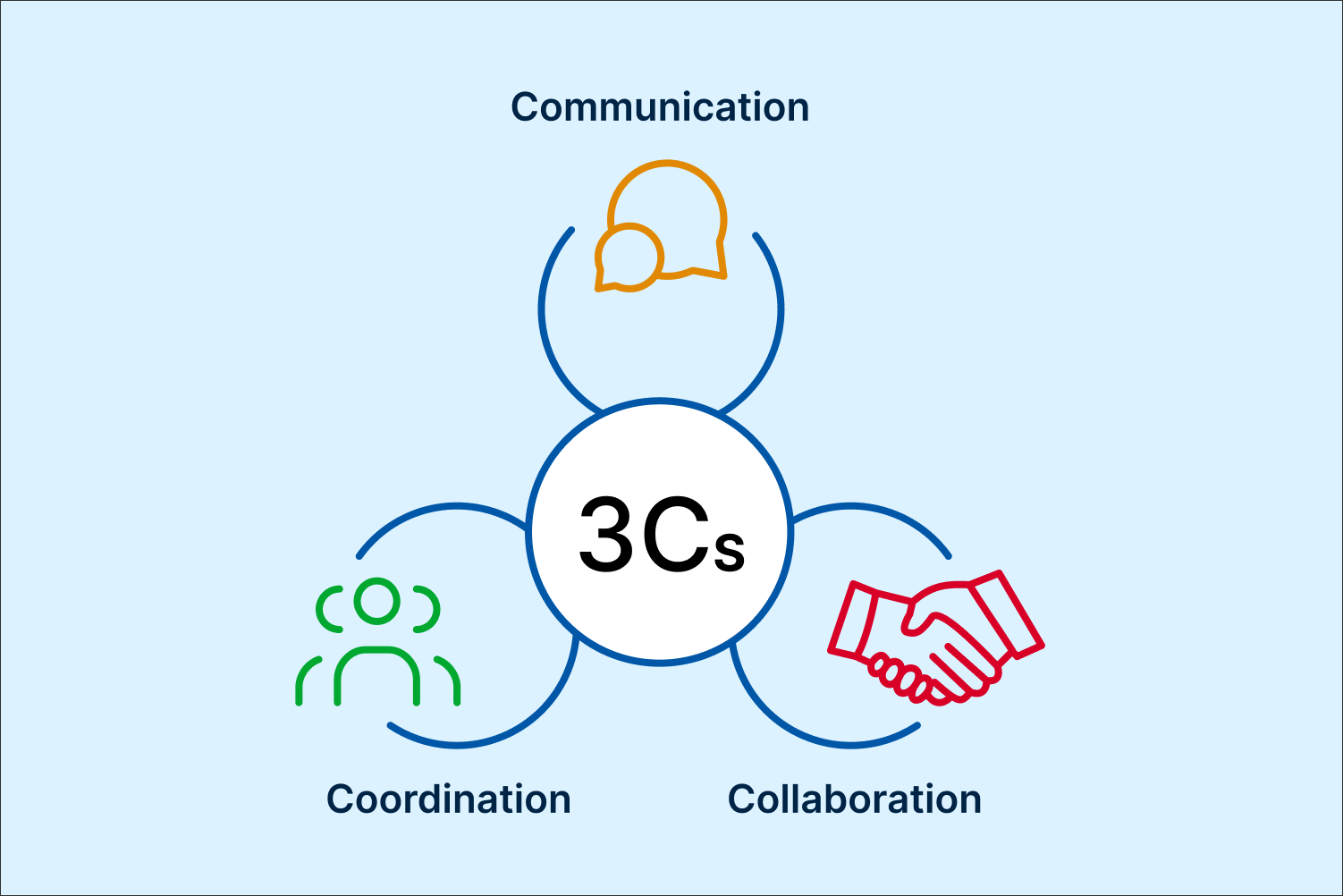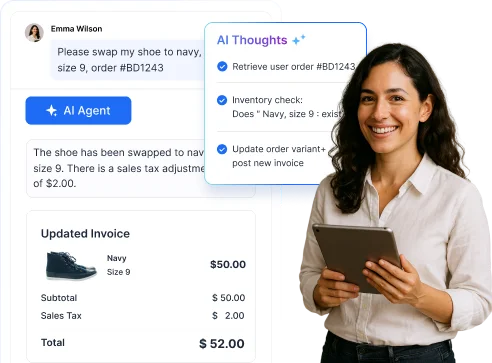Ever wondered why some companies seem to move forward easily while others struggle to keep up? Chances are that the leading companies have figured out how to implement cross-functional teamwork.
Getting teams from different departments and areas of expertise working together is a real key to success.
Imagine a business where the marketing guru, the tech wizard, and the customer service champion all sit at the same table, putting their minds together in pursuit of a common goal.
New ideas emerge. Challenges get solved faster. The result is a level of creativity and innovation that just isn’t possible when people operate separately.
In this blog, we will:
- Unravel the core principles of cross-functional team collaboration
- Explore the benefits and challenges associated with managing such teams
- Provide examples and top strategies to set up and run cross functional teams within your organization
What is a cross-functional team?
A cross-functional team is composed of employees from different departments within a company. They work together on a specific project to achieve shared goals.
These team members usually have the specific skill sets and expertise necessary to complete the project successfully.
Organizations can either assemble a temporary cross-functional team to work on a particular project or form a permanent cross-functional team for all its projects of this nature.
For instance, as companies undergo digital transformation, they might need to create a cross-functional team with IT specialists, data analysts, digital marketing experts, and representatives from key business units.
The team’s goal would be to integrate digital technology smoothly into all areas of the business.
The principles of cross-functional teamwork: The three Cs
A growing number of companies are recognizing the importance of grouping people with a variety of knowledge to reach a shared objective, leading them to foster greater cooperation across departments.
For this cross-functional teamwork to thrive, it must be built upon three foundational elements known as the 3 Cs.

Communication
Communication in cross-functional teams refers to the active exchange of information, ideas, and feedback among team members to ensure everyone is on the same page.
Importance of communication
Clear communication helps bridge the knowledge gaps that exist in cross functional teams, promotes transparency, minimizes misunderstandings, and creates a unified work environment.
It also ensures that every team member understands the project’s objectives, their role, and those of their colleagues.
How to improve communication
To foster open communication among team members:
- Schedule regular team meetings to conduct check-ins
- Use collaboration tools like Microsoft Teams or Slack
- Encourage team members to ask questions or offer feedback
Collaboration
Collaboration is the act of team members working together towards a shared goal, leveraging their individual strengths and expertise.
Importance of collaboration
A recent study by Zippia revealed that 75% of employees rate workspace collaboration as being “very important.”
Collaboration helps bring together diverse talents and perspectives, leading to innovative solutions and better decision-making. It also promotes a sense of unity that increases team spirit.

How to improve collaboration
To help your team members collaborate better:
- Encourage an open and inclusive environment
- Conduct vigorous brainstorming sessions that yield comprehensive solutions
- Value each team member’s contribution
- Foster a sense of shared responsibility
Coordination
Coordination involves organizing and harmonizing the efforts of cross-functional team members to ensure the project is running smoothly.

Importance of coordination
With diverse skills and responsibilities, coordination ensures that everyone is well-aligned with the project’s timelines and overall strategy.
It helps prevent duplicated efforts, allows optimal utilization of resources, and aids in a smooth workflow.
How to improve coordination
To build a well-coordinated, cross-functional team:
- Designate a project manager
- Set up effective project management processes
- Create a project timeline with clear, achievable targets
- Establish clear roles and responsibilities
- Utilize project management tools
Tips for building successful cross-functional team collaboration
Here are some tips you can consider for building and managing effective cross-functional team collaboration.
Establish clear project goals and objectives
Before bringing subject matter experts together in a cross-functional team, set clear project goals with defined deadlines and milestones.
Communicate the purpose of bringing the team together and the expected outcome for all members. This will ensure the team is aligned around a common vision.
Select the right team members
Choose individuals who have the necessary expertise and experience to contribute to the team’s objectives.
Come up with a diverse team in terms of perspective and departmental background to enhance creativity and innovation.
Choose a leader
Appoint a skilled leader who can assign roles to members, facilitate discussions, manage conflicts, and keep the team focused on its goals.
The leader should be able to navigate the different departmental cultures and help the team find common ground.
Define roles and responsibilities
Clearly outline each team member’s role and responsibilities to avoid clashing or repetition of tasks and ensure accountability.
Additionally, ensure that roles are aligned with team members’ strengths and expertise.
Foster open collaboration and communication
Encourage open communication and sharing of information across the cross-functional team.
Use collaboration tools and platforms to facilitate communication, especially if the team is distributed geographically.
Establish strong relationships
Create opportunities for team members to get to know each other on a personal level, such as through team-building activities or informal gatherings.
Create an atmosphere of trust where members feel comfortable sharing ideas and providing honest feedback.
Set up effective conflict resolution procedures
Anticipate and address conflicts early on by establishing clear processes for resolving disagreements.
Encourage a culture of constructive feedback and problem-solving rather than blame.
Schedule regular meetings and updates
Hold regular meetings for the cross-functional team members to track progress, address challenges, and ensure that everyone is still on board and on the same page.

Share updates and successes with stakeholders to maintain transparency and support.
Measure the team’s performance over time
Select the appropriate key performance indicators (KPIs) to measure the team’s progress and success.
Make adjustments to promote optimal performance and productivity.
Hold team members accountable for their contributions but also celebrate achievements as a team.
Cross functional teams examples
Different companies form different kinds of cross functional teams based on their business setup and the products they deliver.
For example, companies that provide customer service software might formulate a cross-functional team to develop a new product.
This team may comprise members from the development, product management, customer support, sales, and marketing departments.
To ensure a project’s success, each department might be tasked with a given role, for instance:
Product lead: Spearheads project execution and makes final decisions.
Communications team: Maintains clear, consistent, and open dialogue with all stakeholders outside the team.
Product development team: Ensures the technical feasibility and execution of the new product.
Product management team: Provides insight into market needs and customer feedback.
Customer support team: Contributes opinions on support materials that should be developed and where customers may need extra help.
The sales team: Offers perspective on how the new feature can meet customer needs.
The marketing team: Devises strategies to communicate the benefits of the product to the current and potential customer base.
As the customer service software is utilized, the cross-functional team actively monitors and analyzes user feedback and performance metrics.
The marketing team may run campaigns to educate customers about the new feature, while the sales team provides feedback from customers to the product team for further refinement.
The customer support team assists customers in leveraging the new functionality and collects firsthand feedback, which is then funneled back to the development team to troubleshoot any issues and make additional enhancements.
Through this cycle of feedback and improvement, the cross-functional team ensures that the customer service software consistently meets and exceeds customer expectations.
Benefits of cross functional team leadership
As organizations strive to navigate complex challenges and innovate at a rapid pace, fostering collaboration across various departments becomes a critical factor in achieving strategic goals.
Cross functional teams are one key to a company’s success for the following reasons:
Help align priorities and goals
By working in cross-functional teams, members gain a better understanding of overall objectives, the contributions made by each department, and what is required to make those contributions.
The team members can better align their efforts.
Help build stronger relationships
Teams that regularly collaborate build an understanding that can help ease the tension that sometimes exists between different groups and smooth over friction points in workflow processes.
Yield innovative solutions and enhance problem-solving capabilities
Exposing teams to new perspectives and ways of thinking fuels creativity. Brainstorming and problem-solving together leads to innovative ideas that push businesses forward.
Complex business challenges often require input from multiple departments, and cross-functional teams have the collective knowledge and experience to tackle issues that go beyond a single business function.
Improve efficiency and productivity
Whenever people with complementary abilities work together towards a common goal, the result is greater than the sum of its parts.
Cross-functional collaboration can significantly boost team and work output and quality.
Enhance communication
Whenever teams work together across disciplines, communication links are strengthened across the organization.
This reduces redundancies and makes the flow of information more efficient.
Enhance the ability to adapt to changing demands
Cross-functional teams have a mix of skills and expertise that enable them to adjust faster to new priorities and challenges, without losing focus.
Challenges of managing cross functional teams and how to overcome them
When a team consists of individuals from various departments and areas of specialization, it’s inevitable that challenges will arise.
Communication breakdowns and barriers
The lack of a common language and comprehension of the roles and contributions of different team members can make it hard for them to convey their thoughts clearly.
This may result in confusion, misunderstandings, and even potential conflicts.
Communication barriers can hinder collaboration, delay project timelines, and ultimately impact the overall success of the team’s objectives.
How can you overcome this challenge?
|
Conflicting priorities
Individuals in collaborative teams often have their primary allegiances to their respective functional areas.
This can lead to a tug-of-war over resources, timelines, key performance indicators, and project directions.
For instance, the finance team could prioritize cost-cutting, which might conflict with the engineering team’s need for high-quality materials.
This misalignment not only hinders decision-making and slows progress but can also foster an environment of misunderstanding and tension.
How can you overcome this challenge?Balancing these competing priorities requires strong leadership, clear communication, and a well-articulated shared goal that aligns the team’s efforts towards the organization’s objectives. |
Lack of trust among team members
Mistrust within cross-functional teams can undermine the collaborative synergy needed for these diverse groups to operate effectively.
When team members harbor doubts about the reliability or competence of their colleagues from different departments, it results in:
- Hiccups in communication
- A reluctance to share information or resources
- Limited innovation
- Unwillingness to take on additional work and effort
- Ineffective decision-making process
- A disjointed approach to problem-solving
How can you overcome this challenge?Choose team members with diverse perspectives and skills, but similar work ethics. Give them a chance to get to know each other in a setting less formal than a business meeting. For example, have the team go out for lunch together one day. |
Difficulties in defining responsibility and accountability
The blend of skills in collaborative teams can be both a strength and a weakness when it comes to determining clear lines of accountability.
Each team member may have different supervisors set by their home department, which can lead to confusion over who is responsible for specific tasks or decisions.
Without clearly defined roles and responsibilities, there can be an overlap of duties or, conversely, critical tasks may slip through the cracks as each member assumes someone else is accountable.
Moreover, the shared leadership structure in cross-functional teams can dilute personal accountability, as team members may feel less individually responsible for outcomes in a group setting.
How can you overcome this challenge?Establish a framework for accountability, including well-documented project plans with:
This will ensure that all members are aligned and accountable for producing their portions of work in a timely manner. Use a task management tool to break down and schedule tasks, define milestones and deliverables, and ensure everyone stays on schedule throughout the project life cycle. |
Miscommunication among team members
While team members bring specialized expertise, the differences in background knowledge can lead to misunderstandings, underutilization of skills, and disjointed efforts.
The terminologies and procedures that are unique to each discipline further derail collaboration efforts and make communication and alignment difficult.
Without a shared understanding, teams may struggle to integrate their efforts effectively, leading to redundant and erroneous work or missed opportunities for working together.
The absence of a common knowledge-sharing platform can also hinder innovation, as team members may not be able to find information quickly and fully grasp the potential application of others’ insights.
How can you overcome this challenge?
|
Leverage the potential of cross-functional teams to unlock next-level success
There is a limit to what you can achieve alone, but when you work with others, there is no boundary to your success. Cross-functional teams are the engine that drives successful modern businesses.
They break down barriers, bring together diverse talents and skills, speed up progress, and lead to better-rounded solutions.
To successfully execute cross-functional teams, tools play a pivotal role, and this is where BoldDesk shines.
BoldDesk enhances team collaboration and efficiency, providing knowledge base software to give your teams grounding and internal support software to organize tasks.
Contact us to schedule a live demo to experience firsthand how BoldDesk’s capabilities can help you get started with your cross-functional team. Or start a free trial to get instant access today.
Related articles



















 Email Ticketing System
Email Ticketing System Shared Inbox Software
Shared Inbox Software Multi Brand Help Desk
Multi Brand Help Desk Internal Help Desk Software
Internal Help Desk Software Trouble Ticketing Software
Trouble Ticketing Software Mobile Help Desk
Mobile Help Desk 
















